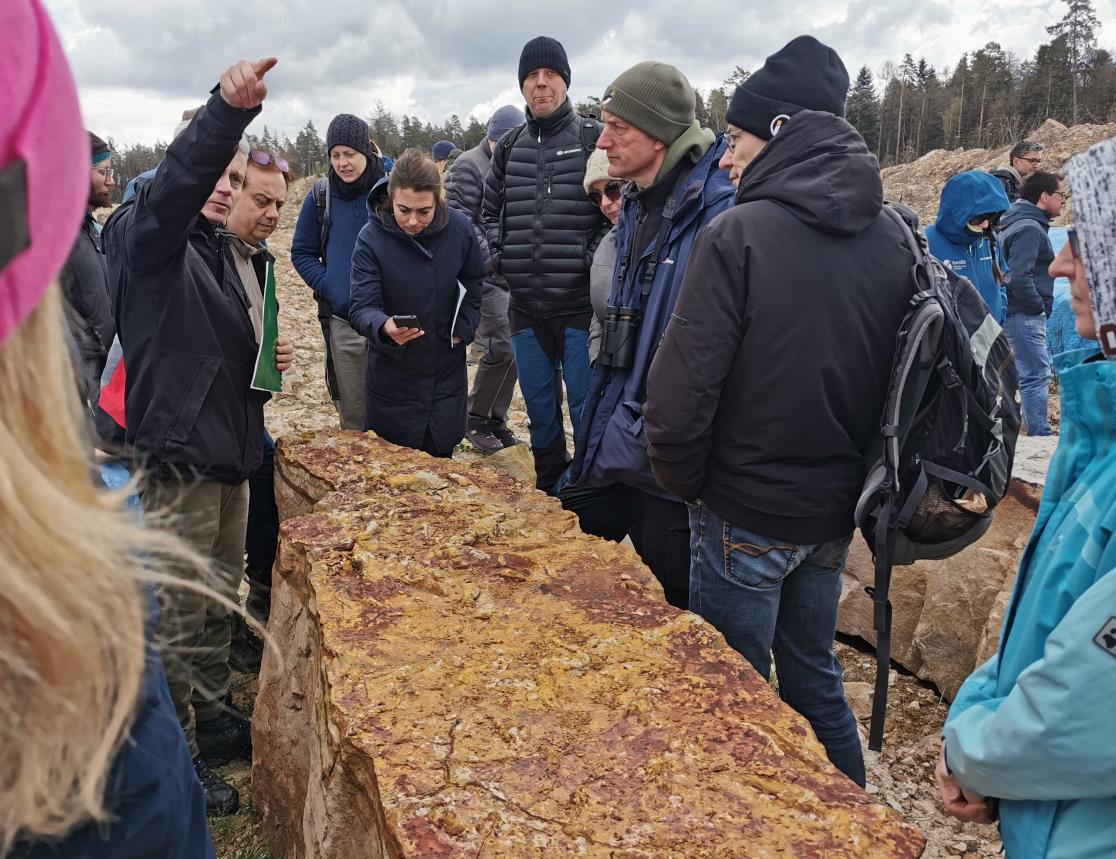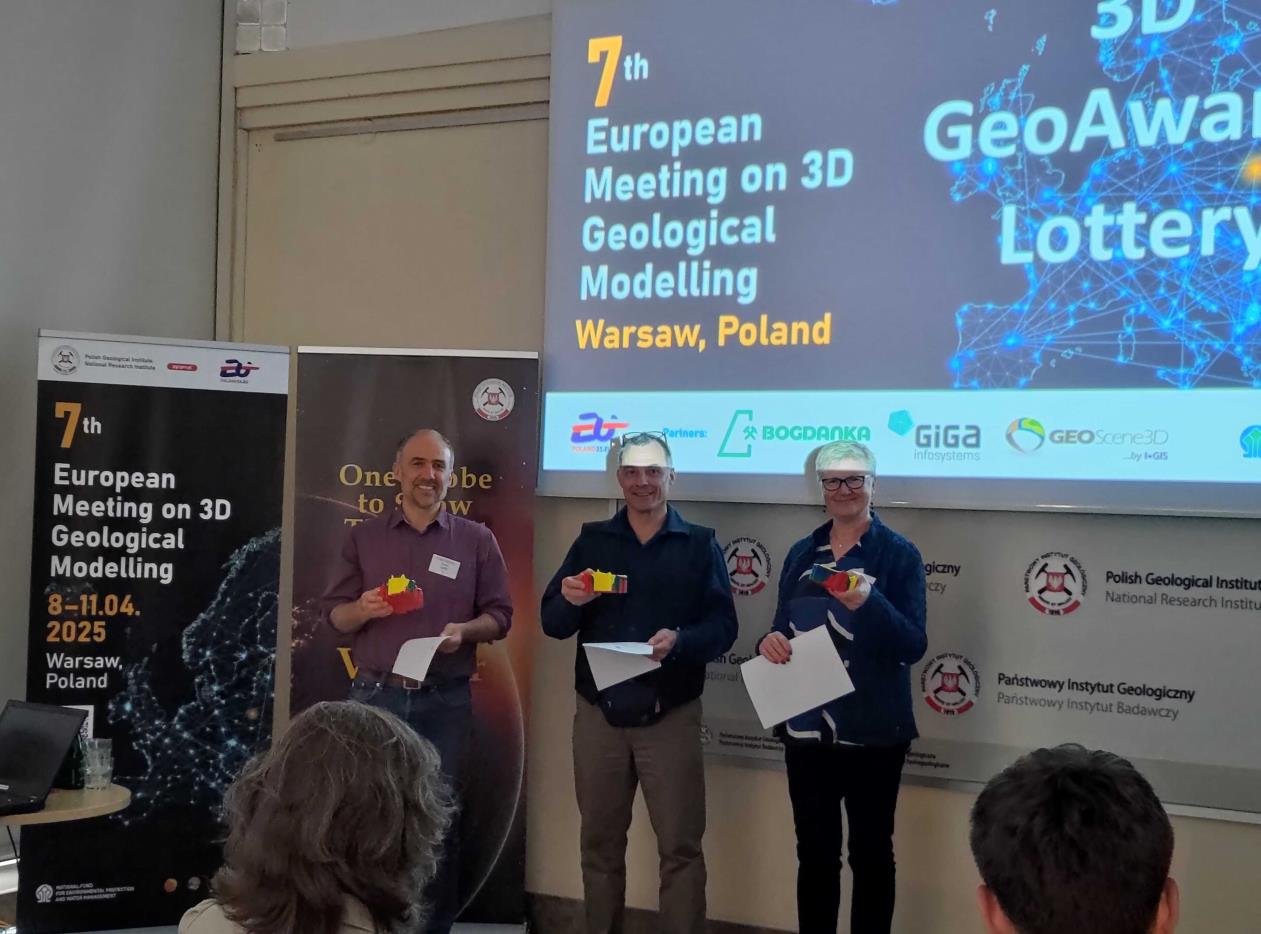 On 8–11 April 2025, the building of the Geological Museum of the Polish Geological Institute – National Research Institute hosted nearly 120 guests from 20 countries, mostly representatives of geological services from Europe and North America. They participated in the seventh European meeting devoted to 3D geological modelling. These meetings are held every two years.
On 8–11 April 2025, the building of the Geological Museum of the Polish Geological Institute – National Research Institute hosted nearly 120 guests from 20 countries, mostly representatives of geological services from Europe and North America. They participated in the seventh European meeting devoted to 3D geological modelling. These meetings are held every two years.
This time, PGI-NRI had the honour of organising the event during the Polish Presidency of the EU.

Participants at the meeting in the Geological Museum of the PGI-NRI
The initial stage of the event was a field trip to the Świętokrzyskie Mountains. The first attraction awaited us along the way — a visit to Borkowice and a collection of dinosaur footprints. The next stops were: Geonatura Kielce – Geoeducation Centre, the ‘Kamieniołom Wietrznia’ nature reserve, and the quarries in Ślichowice. Each of these places allowed participants to better understand the complex geological structure of the Świętokrzyskie region, which is unique in Europe.

Piotr Szrek explains the ichnocenosis of early Jurassic vertebrates in Borkowice

Participants against the backdrop of the tectonic structure of the Ślichowice quarry
The conference was opened by Prof. dr hab. Stanisław Mikulski, Deputy Director of PGI-NRI for Scientific Affairs and Scientific Support of the State Geological Service, who familiarised participants with the Institute's work in the field of geological modelling and concluded his lecture with a video entitled ‘3D Geological Cartography’.

Prof. Stanisław Mikulski welcomed the guests and opened the conference
Next, the meeting organisers, dr Ewa Szynkaruk and dr Zbigniew Małolepszy, presented the conference agenda and unveiled the new interface of the Geo3D browser — a tool enabling exploration of 3D geological models published on the Internet on a virtual globe.
The next part of the meeting consisted of short presentations by representatives of the geological services of each participating country, presenting the current state of geological modelling. This was followed by a poster session, inaugurated by the dynamic ‘Poster Madness’ format — quick, one-minute presentations of each of the 20 posters. Further discussions at the posters took a more traditional, calmer form.

The Geological Museum of PGI-NRI is a unique venue for poster presentations

The poster session began and lasted until the end of the conference
During the rest of the day, participants visited the Geological Museum and then took a long walk around Warsaw.
The second day of the conference brought an intensive, nearly ten-hour programme filled with presentations, discussion sessions and demonstrations by conference partners — Lubelski Węgiel Bogdanka, GigaInfosystems and I-GIS. The substantive sessions discussed:
- methods of geological model communication (including visualisation),
- new challenges and solutions in geological modelling in response to social needs,
- contemporary challenges and innovative approaches in the geological modelling of urban areas.

One of the six lecture sessions was devoted to the application of 3D geological models
The day ended with a gala dinner in a unique location — the historic building of the PGI-NRI Geological Museum.
The next day, the proceedings continued with sessions entitled:
- innovative methods and strategies in geological modelling,
- geological modelling in the face of the challenges of energy transition and sustainable mining — new needs and solutions,
- how to communicate and justify the need to create basic, universal geological models?
The interactive touch screen, on which participants presented their achievements in the field of online geological model browsers, attracted a lot of interest. Most of the presentations concerned models available in the Geo3D browser.

Presentation of the Gothenburg geological model in the Geo3D browser
In addition to digital models, the organisers also presented impressive 3D prints showing a geological model of Poland and selected sedimentary basins. Three models of Poland were awarded to the winners of the 3D GeoAwards lottery. The fourth model — a special non-competition award for perseverance — went to Thomas Jerome, who travelled to the conference from Canada via Australia, where he had spent the first half of the week attending a parallel conference on a similar topic, focused primarily on software solutions for 3D modelling in geology.

The lucky winners of the 3D GeoAwards lottery received 3D prints of a geological model of Poland
The organisers and management of PGI-NRI are confident that this meeting will contribute to the further integration of national and international geological services, supporting the popularisation of modern technologies for mapping geological structures and rock properties, including deposit parameters. The organisers would like to thank everyone involved in the organisation of this event and the partners: Lubelski Węgiel Bogdanka S.A., GigaInfosystem and I-GIS.
Text: Zbigniew Małolepszy, Ewa Szynkaruk














 PGI-NRI offer
PGI-NRI offer Mineral resources of Poland
Mineral resources of Poland  Oil and Gas in Poland
Oil and Gas in Poland 




 Subscribe to RSS Feed
Subscribe to RSS Feed